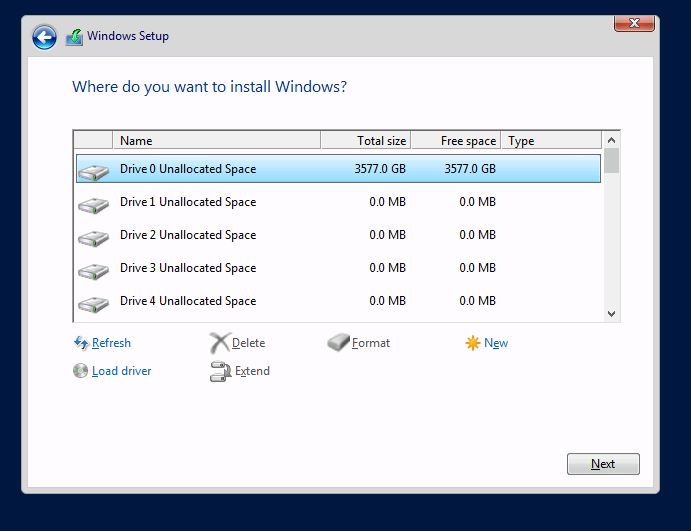8 Windows Issues
This section describes important operating notes and known Windows Server operating system issues for Oracle Server X7-2.
NVMe Phantom Drives Appear When Using Windows Server 2016 Inbox Drivers
Bug ID: 32158109
Issue: During Windows Server 2016 installation on a system with an NVMe storage drive, Windows Setup lists the NVMe storage device and 127 phantom listings of the same NVMe storage device. These phantom storage devices each show a total size and free space of 0.0 MB. For example:

After you install Windows Server 2016, the 127 phantom drives also appear in Windows Device Manager. This issue is due to an out-of-date inbox Windows Server 2016 NVMe driver that does not support the multiple namespace feature of some NVMe storage devices.
Affected Software: Microsoft Windows Server 2016, version 1607 (OS build 14393.3986).
Affected Hardware: Any system with NVMe storage drives that supports multiple namespaces.
Workaround: After Windows Server 2016 is installed, perform a Microsoft Windows Update. A newer version of the Windows Server 2016 NVMe driver installs and corrects the issue. After the update, the phantom drives are no longer listed for your NVMe storage device.
Parent topic: Windows Issues
NVMe Hot Plug Is Not Supported
Important Operating Note
NVMe storage drives are supported by the Microsoft Windows Server 2012 R2 and Windows Server 2016 operating systems. However, NVMe hot plug is not supported on Oracle Server X7-2 under Windows Server 2016 and Windows Server 2012 R2. You must power down the system before removing and replacing NVMe storage drives.
For more information, refer to Servicing Storage Drives (CRU) in Oracle Server X7-2 Service Manual.
Parent topic: Windows Issues
Updated Driver Is Required to iSCSI Boot Windows Server Using Intel i210 Gigabit Ethernet Connection
Bug ID: 25534023
Issue: There is a mismatch between the inbox Intel i210 Gigabit Ethernet driver used during Windows Server setup and the inbox Intel i210 Gigabit Ethernet driver used in the Windows Server operating system. When performing an iSCSI installation using the Intel i210 Gigabit Ethernet connection, the driver mismatch results in a failure to boot the installed Windows Server OS.
Affected Software: Microsoft Windows Server 2012 R2 and Windows Server 2016
Workaround: You must install one of the following newer drivers during server setup:
-
Windows Server 2012 R2 driver INF file:
e1r64x64.inf -
Windows Server 2016 driver INF file:
e1r65x64.inf
These driver files are located in
\windows\drivers\Intel-NIC-1gbe.
Parent topic: Windows Issues